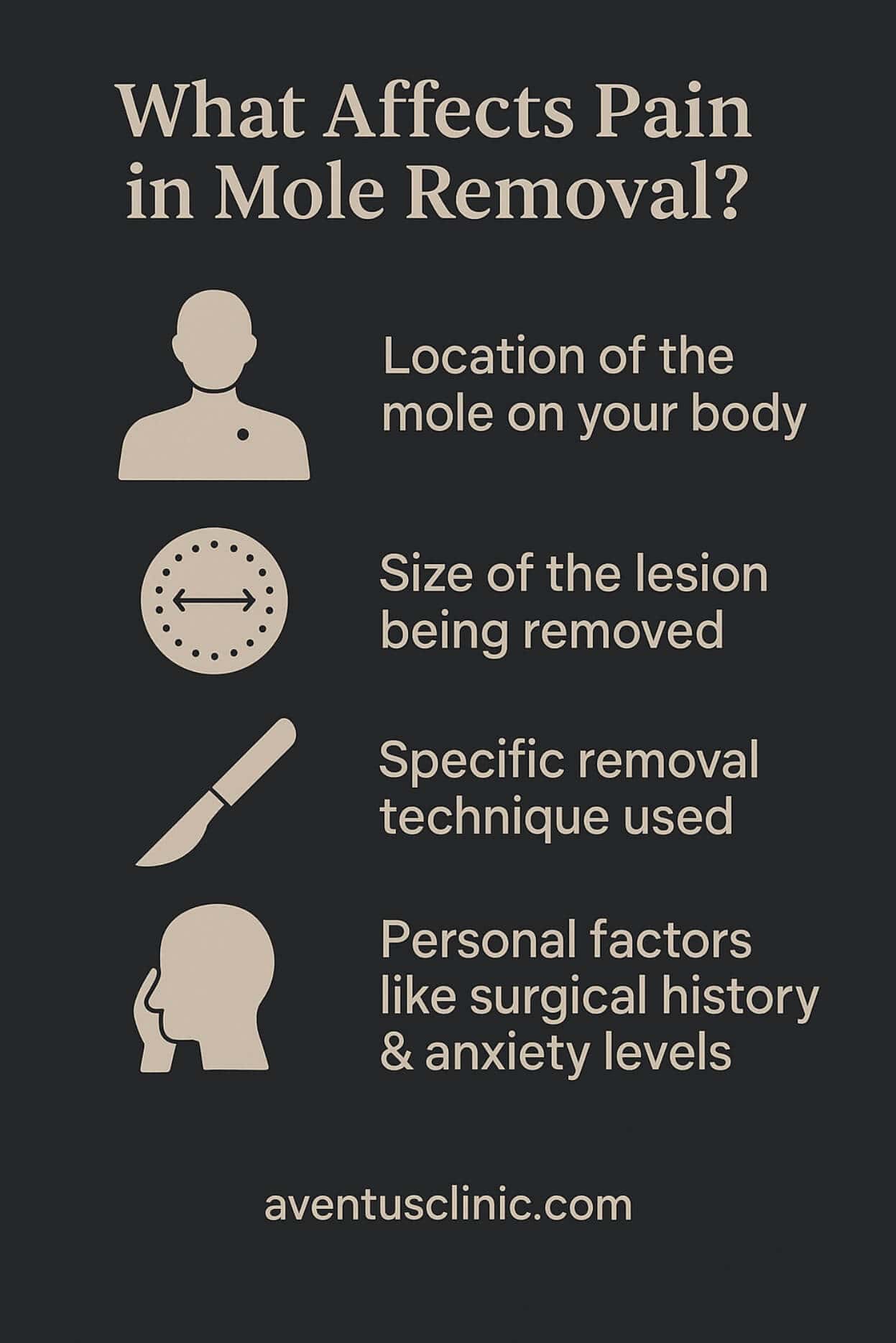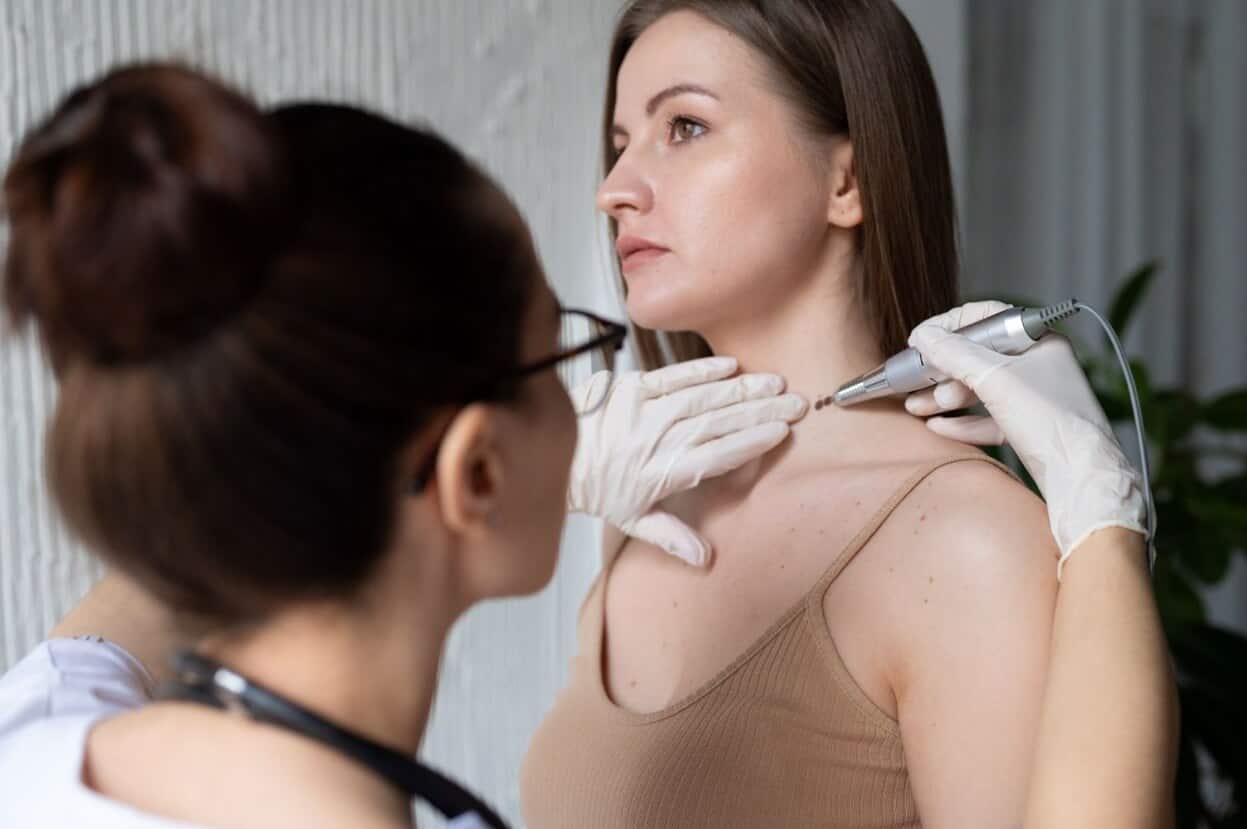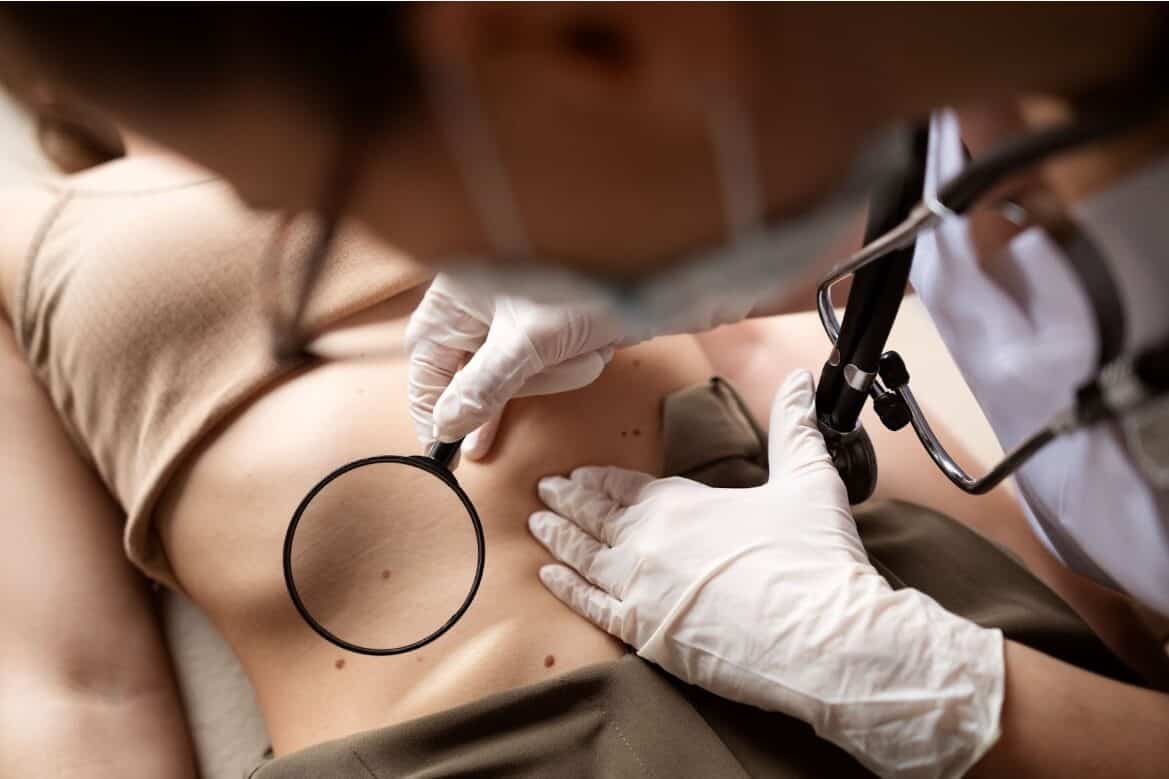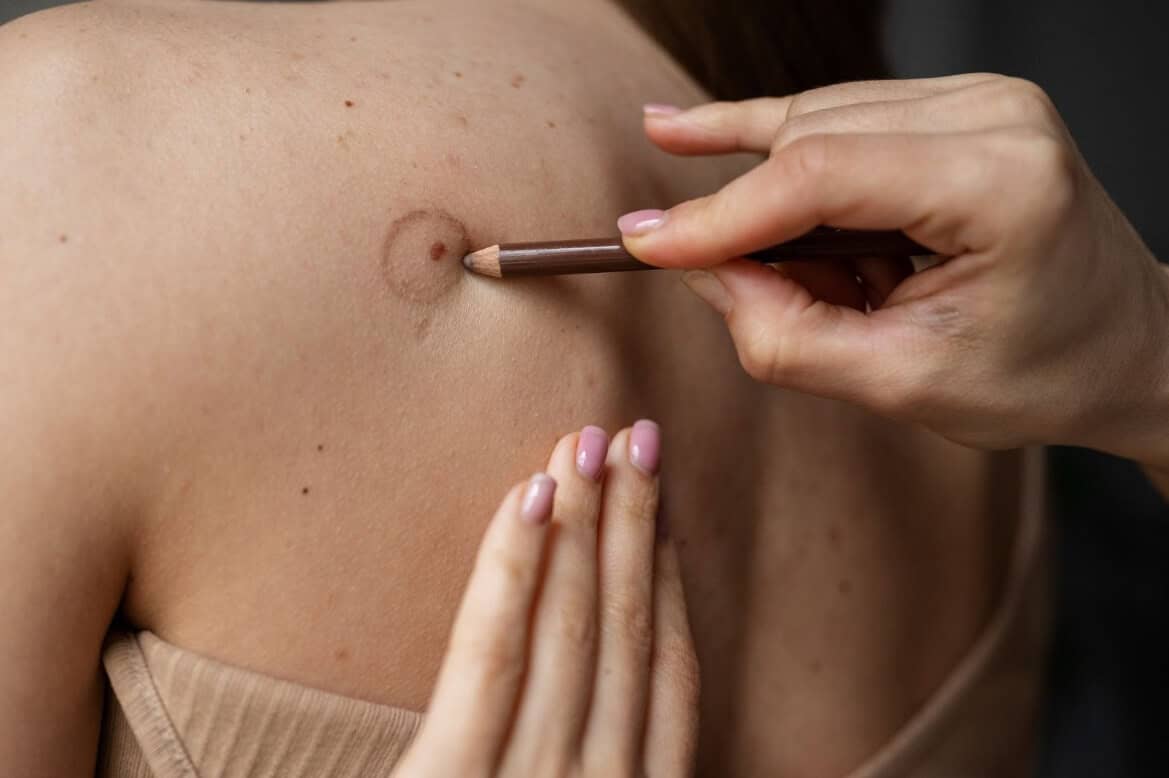Mole removal involves minimal pain thanks to local anaesthesia. Patients feel only brief injection discomfort followed by pressure sensations. Recovery typically features mild tenderness resolving within days.
- Dr Sharon Crichlow
- Reading Time: 10 Mins
Concerns about pain often top the list when considering mole removal. If you’re worried about discomfort during the procedure, rest assured that modern techniques make mole removal a relatively comfortable experience. This article explores what really happens during mole removal, what sensations you might feel, and how recovery typically progresses.
Key Takeaways
- Mole removal procedures use local anaesthesia, making the process virtually painless beyond a brief injection sting.
- Recovery involves minimal discomfort managed with over-the-counter pain relievers and proper wound care.
- Different removal techniques (shaving, excision, laser) offer options based on mole type, with healing times ranging from 1-3 weeks.
Table of Contents
Does Mole Removal Hurt?
The simple answer is that mole removal involves minimal pain when performed by qualified professionals. The procedure begins with a local anaesthetic injection, which temporarily numbs the area around the mole.
Most patients report that the anaesthetic injection feels like a brief pinch or sting lasting only a few seconds. Once the area is numb, you shouldn’t feel any sharp pain during the actual removal.
What you might experience instead are sensations of pressure, tugging, or pulling as the doctor works on the area. These sensations aren’t painful but can feel unusual.
Recent research supports this experience. A 2024 study published in the Wiley Online Library found that pain during dermatologic procedures is typically mild, with several factors influencing individual experiences.

How Is Mole Removal Performed?
Mole removal is a straightforward procedure that typically takes about 30 minutes. The process varies slightly depending on the type of mole and its location, but generally follows these steps:
1. Local Anaesthetic Application
The procedure begins with cleaning the area with an antiseptic solution. The doctor then administers a local anaesthetic injection near the mole. Within minutes, the area becomes numb, ensuring you remain comfortable throughout the procedure.
2. Removal Technique
Depending on your specific case, the doctor will use one of several removal methods:
| Technique | Best For | Process | Recovery Notes |
|---|---|---|---|
| Shave Excision | Raised moles | Uses a razor blade to shave off the mole and some surrounding skin | Minimal scarring, faster healing |
| Surgical Excision | Deeper or suspicious moles | Removes the mole with a scalpel, along with some surrounding tissue | May require stitches, more thorough removal |
| Laser Removal | Superficial or flat moles | Uses precise laser energy to break down mole cells | Minimal scarring, may require multiple sessions |
Your specialist at our mole checking service will determine the most appropriate technique based on the characteristics of your mole and your medical history.
3. Post-Removal Care
Once the mole is removed, the doctor cleans the area again and may apply an antibiotic ointment. Depending on the removal method, they might:
- Place stitches to close the wound (common with surgical excision)
- Apply a special dressing to promote healing
- Provide specific aftercare instructions
The removed mole is typically placed in a specimen container and sent for laboratory analysis when necessary.
What to Expect After Mole Removal
Recovery after mole removal is usually straightforward, with most patients experiencing minimal discomfort.
A large study of 2,178 patients found that postoperative pain after skin removal procedures was generally low, typically peaking on the first day after surgery and diminishing thereafter.
During the first 24-48 hours, you might notice:
- Mild tenderness around the removal site
- Slight redness and swelling
- A small scab forming over the area
These symptoms are normal parts of the healing process. Most people find that over-the-counter pain relievers like paracetamol are sufficient to manage any discomfort.
Your healing timeline will depend on the size and location of the removed mole, as well as the technique used:
- For shave excisions: Healing typically takes 7-10 days
- For surgical excisions with stitches: Complete healing may take 2-3 weeks
- For laser treatments: The area usually heals within 1-2 weeks
Following your doctor’s wound care instructions is crucial for minimising discomfort and promoting optimal healing with minimal scarring.
Is Mole Removal Safe?
Mole removal is generally very safe when performed by qualified healthcare professionals. The procedure has been routinely performed for decades with excellent safety records.
The risk of complications is minimal, with infection rates as low as 0.4-2.5% according to a 2021 review published in PMC. Most complications, when they do occur, are minor and easily managed.
However, it’s worth noting the significant contrast between professional removal and DIY attempts. A 2023 FDA study documented 38 cases of serious injuries from unapproved topical mole removers, including burns, ulceration, and scarring.
At our Hertfordshire mole removal clinic, we maintain strict protocols to ensure patient safety:
- Sterile equipment and environment
- Qualified specialists performing all procedures
- Comprehensive pre-procedure assessment
- Detailed aftercare instructions
- Follow-up support as needed
The safety of professional mole removal extends beyond the procedure itself. Having moles professionally examined can be potentially life-saving, as suspicious moles can be identified and tested for skin cancer.
Conclusion
Mole removal is a quick, simple procedure with minimal pain for most patients. With proper anaesthesia and technique, the process itself causes little discomfort, while recovery is typically straightforward with mild, manageable tenderness.
If you’ve noticed a concerning mole or simply want one removed for cosmetic reasons, don’t let fear of pain hold you back. Book your free online assessment today, and our specialists will guide you through the process, ensuring your comfort every step of the way.
FAQs
Does mole removal hurt with anaesthetic?
With proper local anaesthetic, you should feel little to no pain during mole removal. You’ll likely experience some pressure or tugging sensations, but these aren’t painful. The anaesthetic injection itself causes a brief sting lasting just seconds before the area becomes numb.
How long does recovery take?
Most patients recover from mole removal within 1-3 weeks, depending on the removal method and location. Shave excisions typically heal faster (7-10 days) than surgical excisions with stitches (2-3 weeks). Follow your doctor’s aftercare instructions carefully for optimal healing.
Is laser mole removal painful?
Laser mole removal is performed with local anaesthetic, making the procedure itself virtually painless. Afterwards, the area might feel similar to a mild sunburn for 1-2 days. Most patients find this discomfort easily manageable with over-the-counter pain relievers.
What does healing feel like?
During healing, most patients experience mild tenderness and occasional itching around the removal site. A Danish study found that only about 9.7% of patients reported notable pain in the scar area after dermatologic procedures, with most describing it as mild with minimal impact on daily activities.
How can I manage discomfort after mole removal?
Most post-procedure discomfort can be managed with simple measures: take paracetamol as directed, apply cold compresses to reduce swelling, keep the area clean and protected according to your doctor’s instructions, and avoid activities that might stretch or irritate the healing site.
Will there be a scar after mole removal?
Some degree of scarring is possible after mole removal, but modern techniques minimise this. The extent of scarring depends on the size and location of the mole, removal technique, your skin type, and how well you follow aftercare instructions. Many scars fade significantly over time.
When can I resume normal activities after mole removal?
Most patients can return to normal activities immediately after mole removal, though you should avoid strenuous exercise for 1-2 days. For facial moles or those in areas that move frequently, your doctor might recommend limiting certain expressions or movements briefly to support healing.
 Free Online Assessment
Free Online Assessment WHATSAPP
WHATSAPP







